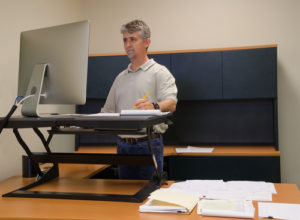As a chiropractor in a busy office, I often witness trends in the healthcare field. One of the latest trends has been the rise in popularity of the standing desk. These desks offer the opportunity for our 80% sedentary workforce to perform their jobs while standing instead of sitting. Although this may have some benefits, a standing desk may not be right for everyone. Is a standing desk right for you?
 There is no doubt that prolonged sitting has led to an increase in unhealthy individuals since the invention of the desktop computer. Prolonged sitting has been linked to obesity, back pain, poor circulation, headaches, poor spinal posture, and more. I have spent my career trying to educate my patients on how they can fix these problems often caused by sitting too long. Is a standing desk a viable option for those who are trying to reduce these health concerns? And are there problems created by a standing desk?
There is no doubt that prolonged sitting has led to an increase in unhealthy individuals since the invention of the desktop computer. Prolonged sitting has been linked to obesity, back pain, poor circulation, headaches, poor spinal posture, and more. I have spent my career trying to educate my patients on how they can fix these problems often caused by sitting too long. Is a standing desk a viable option for those who are trying to reduce these health concerns? And are there problems created by a standing desk?
From my experience of patients who have made the switch to a standing desk, there have been some consistent benefits. Forward head posture, which is often created with poor sitting posture, appears to be greatly reduced when my patients have made the switch. Standing helps to reduce the stress on the shoulders, neck, and head, reducing spinal pain and headaches. Elbow tension is also often reduced due to the activation of the postural muscles of the shoulder girdle thereby reducing increased muscle contraction at the elbow. Hip pain has also been shown to be reduced in many patients who have used a standing desk. Standing appears to reduce the tension on the hip, while allowing for better blood flow to the muscles in the legs.
Obviously, good ergonomic rules still apply with a standing desk and the following are the most important:
Ergonomic Rules Of A Standing Desk:
- The monitor should be at or above eye level.
- Shoulders should be over your hips and/or center of gravity.
- Arms should be relaxed when in the keyboarding position.
- Feet should be shoulder width apart and parallel with the shoulders or staggered with one foot in front of the other.
 Studies have yet to show that a standing desk has a significant impact on overall body fat and weight. However, I have seen an increase in muscle tone of the hips and legs from the increase in standing. This is especially important for women as the legs contain their largest amount of muscle mass and their greatest potential to burn more calories during the day.
Studies have yet to show that a standing desk has a significant impact on overall body fat and weight. However, I have seen an increase in muscle tone of the hips and legs from the increase in standing. This is especially important for women as the legs contain their largest amount of muscle mass and their greatest potential to burn more calories during the day.
Possible Problems Created By A Standing Desk
Besides the cost of a brand-new piece of office equipment, a standing desk can create some concerns. For those that suffer from foot, knee, and hip pain, the increased pressure from prolonged standing can increase joint pain. My recommendation has always been to increase the amount of standing time slowly. Do not try to stand for 8 hours on your first day at your new desk. Break in your desk like a new pair of running shoes. Take your time and be patient, allowing for your body to adapt to the new stressors. Try standing for 20 minutes and then sit for 40 minutes in the beginning. After a few days, start to increase the standing time each hour, allowing enough time for your legs and postural muscles to rest before standing again. I firmly believe that even the most arthritic patients can benefit from less sitting and more standing, just proceed wisely.
If your back starts to hurt after using your standing desk, realize this may be due to your back muscles having to actually work. Give your back muscles a break by placing a small footstool or box under the standing desk. Place one foot on the box, alternating feet about every 20 minutes. This small change moves your body’s center of gravity forward giving your back muscles a much-needed rest. A footstool will help remedy most postural issues for those who sit or stand at any desk.
Don’t forget to still perform your hourly “micro breaks” to give your spinal muscles a chance to refresh. Try one of these three exercises for 1-2 minutes each hour:
 Bruegger’s Stretch — Stand with your feet shoulder-width apart, arms at your side, and as tall as you can stand. Slowly rotate backwards your thumbs leaving the palms of your hands facing forward or up to the ceiling. Take a deep breath in slow and exhale even more slowly. Repeat 3X.
Bruegger’s Stretch — Stand with your feet shoulder-width apart, arms at your side, and as tall as you can stand. Slowly rotate backwards your thumbs leaving the palms of your hands facing forward or up to the ceiling. Take a deep breath in slow and exhale even more slowly. Repeat 3X.
Standing Cross Crawl — Stand with your hands outstretched in front of you at waist level. Raise one of your knees to meet the hand of the opposite side. Repeat this marching motion while raising the level of your hands as the tension in your hips reduces. Perform the standing cross crawl for 1 minute.
Go for a short walk — The easiest exercise to do is simply walk away from your desk. Go for a short walk up the stairs or down the hall. Try to get to a full fast stride allowing for your arms to swing freely. This simple activity is fantastic for reducing head, neck, and shoulder tension while improving circulation in your legs.
 For more exercises to benefit your head, neck, and shoulders see our short YouTube video by using this QR code. We want to equip you with a variety of tools to improve your life. Our desire at [Core] is to see our patients reach new heights of personal health. Let us know how we can help you!
For more exercises to benefit your head, neck, and shoulders see our short YouTube video by using this QR code. We want to equip you with a variety of tools to improve your life. Our desire at [Core] is to see our patients reach new heights of personal health. Let us know how we can help you!

Daryl C. Rich, D.C., C.S.C.S.






